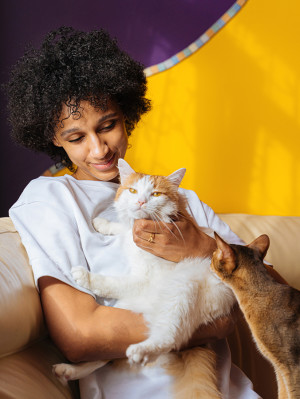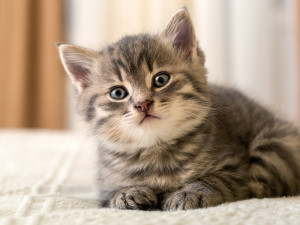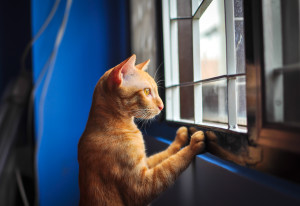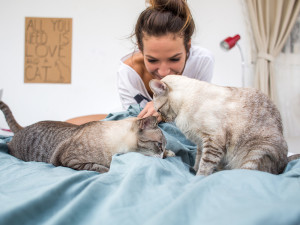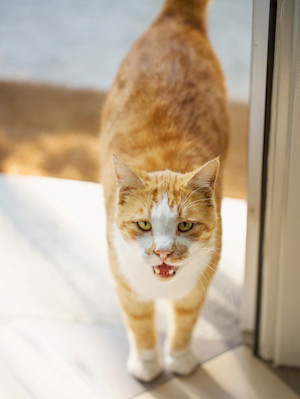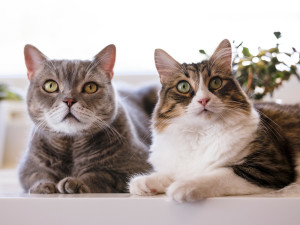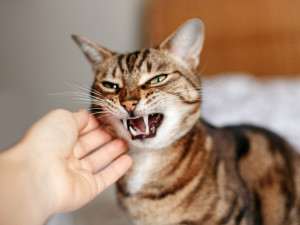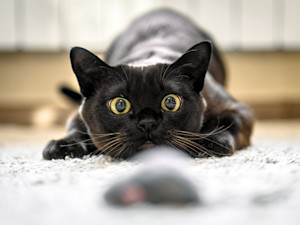What Are Cat Pheromones and How Do They Work?
Communication is key, and pheromones are your cat’s version of DMs
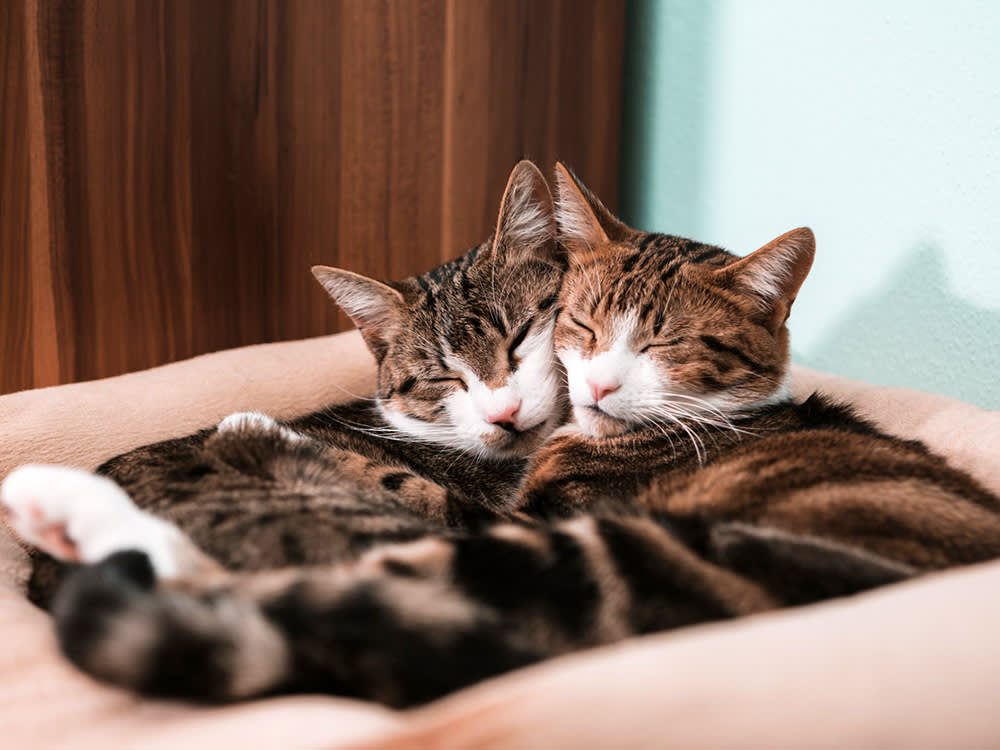
Share Article
Cat pheromones are used to mark territory, attract mates and communicate other important messages. Synthetic cat pheromones are available in a variety of products that can be used to help cats feel safe and secure, and to reduce stress and anxiety.
What are cat pheromones?
Pheromones are chemical substances that affect animal behaviour and emotion. Cats use pheromones as one of many possible methods to communicate with each other. Cats release pheromones by scratching, urinating or rubbing themselves on various surfaces. Mother cats also release pheromones from their mammary glands to let their kittens know they’re safe. Pheromones relay information about a cat’s identity and reproductive state.

littleKin™ is Kinship’s home just for puppy and kitten parents. Bop over to check out expert advice, new pet tools, and special deals—all curated for your newest family member.
opens in a new tabWhen cats encounter pheromones, they detect the chemicals with their vomeronasal organ (VMO). The vomeronasal organ is a sensory organ located in a cat’s nasal cavity with ducts that connect to the front of their hard palate. When a cat senses that they’ve encountered pheromones, they will try to gain more information by licking their nose or scrunching up their face in an effort to get more of the scent to their VMO. This is called a flehmen response.
The flehmen response is a voluntary behaviour. It involves a cat opening their mouth, lifting their lips and staring off as if they’re deep in thought. It can look like a sneer or a grimace. So if a cat is suddenly making a ‘who farted?’ face, they may have detected another cat’s pheromones.
What are the types of cat pheromones?
Different types of cat pheromones will elicit different responses in cats. Pheromones are typically grouped together by how they work instead of what they’re made of. These are the major categories of cat pheromones.
Feline facial pheromones
Feline facial pheromones are the ‘feel good’ pheromones that make kitties feel happy and safe. These have been broken down into five subcategories – F1 to F5 – but the function of every subcategory is still not known.
F1 (function unknown)
F2 (male sexual behaviour): male cats will rub their face on objects to attract mates.
F3 (territorial behaviour): cats will mark objects and areas that they commonly encounter.
F4 (tactile communication): cats will mark individuals, including humans and other animals, that they consider to be familiar. This is done in the form of ‘allorubbing’ (rubbing themselves on one another) or ‘allogrooming’ (grooming one another).
F5 (function unknown)
Cat-appeasing pheromones
Cat-appeasing pheromones, sometimes called mother cat pheromones, are produced by the mother during lactation. Sebaceous glands around a mother cat’s nipples release these pheromones soon after she gives birth until soon after the kittens are weaned. Cat appeasing pheromones help kittens feel comforted and form bonds with their mother, each other, and anyone their mother marks as ‘safe’.
Feline interdigital semiochemical
Cats also produce a feline interdigital semiochemical with the glands on their paws. When cats scratch and ‘make biscuitsopens in a new tab’ on a surface, they leave scents behind that mark their territory. The scratches themselves also serve as a visual cue that the cat has claimed the area.
Male cat pheromones
Male cats will often use urine spraying to mark their territory and communicate with other neighbouring cats. Male cat pheromones communicate to female cats that a potential mate is nearby. They also send messages to other male cats that a potential competitor has been around. Aggressive tomcats may take this as an invitation to fight, while more submissive cats can take this as a cue to scram.
How are pheromones used to affect cat behaviour?
Researchers have discovered clear links between pheromones and feline behaviour. Some manufacturers have taken advantage of this by creating synthetic pheromones to help alter cat behaviour.
Using pheromones to reduce stress and anxiety in cats
Synthetic pheromones can help reduce stress and anxiety in cats. Feline facial pheromones are used to make objects and environments feel more ‘familiar’. They also have a calmingopens in a new tab effect on some cats, allowing them to adjust more easily to stressful situations or unfamiliar places. Synthetic feline facial pheromones can be used to reduce urine spraying, furniture scratching, compulsive grooming and hiding.
Using pheromones to promote healthy social behaviour in cats
Cat-appeasing pheromones can be used to calm cats in multi-cat households. The cat-appeasing pheromone is naturally released by a mother cat to make her kittens feel safe, secure and bonded. The synthetic cat-appeasing pheromone is used to decrease tension between cats and make them feel more familiar and bonded to each other. It can also help when introducing a new cat. The cat-appeasing pheromone is often used in an effort to reduce fighting for space, attention and resources (food guarding).
What are the benefits of using cat pheromone?
There are many potential benefits to using cat pheromones. Many cat parents turn to synthetic cat pheromones to encourage relaxation, reduce inter-cat aggression, or curb nuisance behaviours. While some cat parents have had great success with feline pheromones, results vary. Situations where a cat may benefit from pheromones include:
Stressful environmental changes (like new people, places or pets)
Introducing a new cat
Anxiety-inducing car rides (including trips to the vet)
Inappropriate urination
Aggressive behaviour towards people or other pets
Extreme fear of people or other pets
Separation anxiety
Which products use cat pheromones?
Synthetic cat pheromones are available in multiple modalities, so cat parents can choose whichever seems best for their cat.
Pheromone diffusers for cats
A diffuser is a device that disperses pheromones into the air. Pheromones diffusers for cats should be used in the room where a cat spends the most time. When placed properly, the diffusers can cover a pretty large area (up to 700 sq ft) and last anywhere from four to six weeks. Pheromone diffusers are formulated for both single-cat and multi-cat households.
Cat pheromone sprays
Cat pheromone sprays offer convenience by providing pheromones in travel form. Cat pheromone sprays can be used to pre-treat travel carriersopens in a new tab before car rides. They can also spot-treat problem areas, like furniture that cats are scratching or areas chosen for inappropriate urination. The sprays can quickly create a calming environment and mark objects as claimed (so your cat doesn’t feel the need to mark them). Keep in mind that pheromone sprays are made for objects, not to be sprayed directly on to cats.
Pheromone wipes
Cat pheromone wipes are similar to sprays in that they can be applied directly to objects to make them more appealing for relaxation and less appealing for scratching and urination. Pheromone wipes are not to be used directly on cats.
Pheromone cat collars
Cat parents looking for a ‘put it on the cat’ option may opt for a cat pheromone collar for behaviour modification or stress reduction. Cat pheromone collars slowly release pheromones over a period of weeks. This is an option for kitties who travel, go outdoors, are engaging in nuisance behaviours (scratching or urinating), or are experiencing a major change in their environment.
Frequently asked questions
Do cat pheromones work on humans?
Cat pheromones are not detectable by humans and do not have any effect on human behaviour. Cats will choose to communicate with their people in other ways.
What do cat pheromones smell like?
Cat pheromones do not have odours that are detectable by humans. When using synthetic pheromone products, the carrier oils or other ingredients in the product may have a faint odour.
References:

Dr. Alycia Washington, DVM, MS
Alycia Washington, DVM, is a small animal emergency veterinarian based in North Carolina. She works as a relief veterinarianopens in a new tab and provides services to numerous emergency and specialty hospitals. Dr. Washington is also a children’s book author and freelance writer with a focus on veterinary medicine. She has a special fondness for turtles, honey bees, and penguins — none of which she treats. In her free time, Dr. Washington enjoys travel, good food, and good enough coffee.
Related articles
![Red Cat On Threshold Looks At The Camera And Meows.]() opens in a new tab
opens in a new tabWhy Is My Cat Heavy Breathing?
This can happen over time or very suddenly. Either way, it’s important to learn more about this symptom
![Male and female cat lying side by side.]() opens in a new tab
opens in a new tabMale vs Female Cats: What Are the Differences?
There’s more to it than you might think
![Cat hissing at a person attempting to pet its cheek]() opens in a new tab
opens in a new tabDoes Your Cat Hate Your New Partner?
How to help your kitty warm up to your SO
![Mom cat and her kittens.]() opens in a new tab
opens in a new tabHow to Tell if a Cat is Pregnant
Are kittens on the way? Here’s how to find out
![]() opens in a new tab
opens in a new tabHow Cats Hunt
Cats have evolved to be skilled hunters, but how and why do they still do it?
![Cat eating out of metal bowl]() opens in a new tab
opens in a new tab9 Foods You Should Never Feed Your Cat
Sharing isn’t always caring. Keep your cat safe by keeping these human snack staples to yourself
